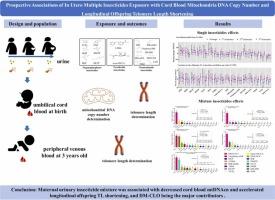Prospective Associations of In Utero Exposure to Multiple Insecticides with Cord Blood Mitochondria DNA Copy Number and Longitudinal Offspring Telomere Length Shortening
IF 11.3
1区 环境科学与生态学
Q1 ENGINEERING, ENVIRONMENTAL
引用次数: 0
Abstract
Widespread insecticide exposure can cause adverse health outcomes in offspring due to maternal exposure via elevating oxidative stress levels, which may be evidenced through variations in telomere length (TL) and mitochondrial DNA copy number (mtDNAcn). However, the potential risks of in-utero exposure to multiple classes of insecticides at environmentally relevant doses on offspring's TL and mtDNAcn in early life are still poorly understood. This study aimed to elucidate associations between in-utero exposure to organophosphates, pyrethroids, neonicotinoids and cord blood mtDNAcn and offspring TL shortening. Maternal urinary metabolites of these insecticides were repeatedly measured in three trimesters. Relative mtDNAcn (n = 520) in cord blood and relative TL (n = 299) in cord blood & blood samples of three years old toddlers were also measured. The results showed that the first-, second-, and third-trimester insecticide mixtures were all significantly associated with reduced cord blood mtDNAcn, and the association was primarily driven by desmethyl-clothianidin (DM-CLO). Additionally, the second-trimester insecticide mixture was significantly associated with TL attrition, with DM-CLO being the primary contributor. Our findings showed that in-utero insecticide mixture exposure was related to decreased cord blood mtDNAcn and accelerated longitudinal offspring TL attrition, with DM-CLO being the major contributor.

子宫内暴露于多种杀虫剂与脐带血线粒体DNA拷贝数和子代纵向端粒长度缩短的前瞻性关联
广泛的杀虫剂暴露可通过提高母亲的氧化应激水平对后代造成不利的健康后果,这可能通过端粒长度(TL)和线粒体DNA拷贝数(mtDNAcn)的变化来证明。然而,子宫内以环境相关剂量暴露于多种杀虫剂对后代早期TL和mtDNAcn的潜在风险仍然知之甚少。本研究旨在阐明子宫内暴露于有机磷、拟除虫菊酯、新烟碱类和脐带血mtDNAcn与后代TL缩短的关系。在妊娠三个月期间反复测量这些杀虫剂的母体尿代谢物。还测量了三岁幼儿脐带血中相对mtDNAcn (n = 520)和相对TL (n = 299)。结果表明,妊娠早期、中期和晚期混合杀虫剂均与脐带血mtDNAcn降低显著相关,这种关联主要是由去甲基噻虫胺(DM-CLO)驱动的。此外,中期混合杀虫剂与TL消耗显著相关,其中DM-CLO是主要贡献者。我们的研究结果表明,子宫内混合杀虫剂暴露与脐带血mtDNAcn降低和子代纵向TL消耗加速有关,其中DM-CLO是主要贡献者。
本文章由计算机程序翻译,如有差异,请以英文原文为准。
求助全文
约1分钟内获得全文
求助全文
来源期刊

Journal of Hazardous Materials
工程技术-工程:环境
CiteScore
25.40
自引率
5.90%
发文量
3059
审稿时长
58 days
期刊介绍:
The Journal of Hazardous Materials serves as a global platform for promoting cutting-edge research in the field of Environmental Science and Engineering. Our publication features a wide range of articles, including full-length research papers, review articles, and perspectives, with the aim of enhancing our understanding of the dangers and risks associated with various materials concerning public health and the environment. It is important to note that the term "environmental contaminants" refers specifically to substances that pose hazardous effects through contamination, while excluding those that do not have such impacts on the environment or human health. Moreover, we emphasize the distinction between wastes and hazardous materials in order to provide further clarity on the scope of the journal. We have a keen interest in exploring specific compounds and microbial agents that have adverse effects on the environment.
 求助内容:
求助内容: 应助结果提醒方式:
应助结果提醒方式:


